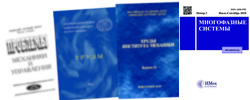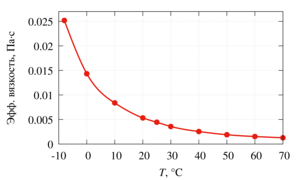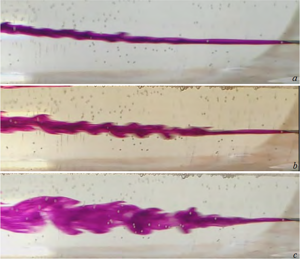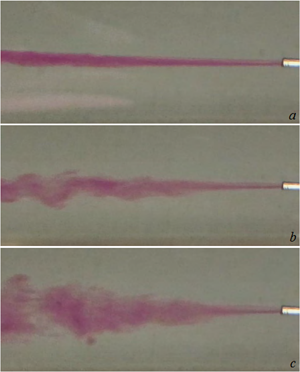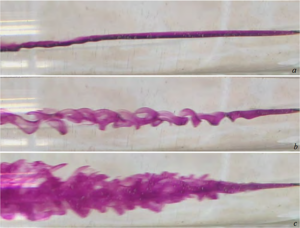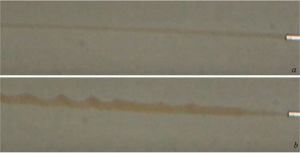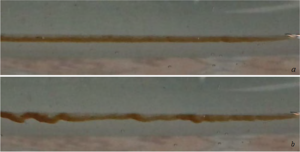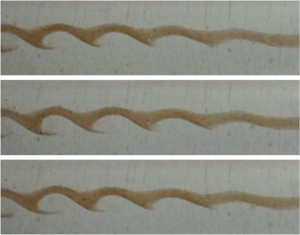Mukhutdinova A.A., Nizаmova A.D., Kireev V.N.
Experimental study of hydrodynamic stability of liquid flow in an annular channel. Multiphase Systems. 20 (2025) 1. 1–6 (in Russian).
Experimental study of hydrodynamic stability of liquid flow in an annular channel
A.A. Mukhutdinova
1, A.D. Nizаmova
1 🖂, V.N. Kireev
21Mavlyutov Institute of Mechanics of UFRC RAS, Ufa, Russia
2Ufa University of Science and Technology, Ufa, Russia
Abstract
The issues related to transient modes of fluid flow in channels of various cross-sections are among the most important in solving applied
problems of hydrodynamics. In the design of heat exchange devices, cooling systems and industrial condensers, it is essential to take
into account the non-uniform temperature distribution on the flow characteristics. The problem of determining the conditions of the
laminar–turbulent transition under conditions of intense heat exchange seems to be especially relevant. In this paper, an experimental
study of the effect of the thermal viscosity parameter on the hydrodynamic stability of flow in an annular channel is performed. The
dynamic viscosity of liquids should be considered as a function of temperature and for different heat carriers and depends on their physical
properties. Earlier, it was theoretically established that taking into account the non-uniformity of the viscosity distribution over the channel
cross-section can significantly affect the critical values of the Reynolds number. For this purpose, experiments were carried out on a setup
based on two horizontally located coaxial pipes made of transparent material. The inner pipe contained a heating element to create a
temperature gradient in the cross-section of the annular channel. The transition from laminar to turbulent flow was determined visually
using a potassium permanganate solution. To minimize the influence of convective flows, a hollow needle through which the coloredliquid was supplied was located in the lower part of the annular channel. The experiments were carried out with beveled and straight-cut
needles. Water and 45% aqueous propylene glycol solution were selected as working fluids for the experiment. To determine the thermal
viscosity parameter, detailed viscosity measurements of a 45% aqueous propylene glycol solution were carried out in the temperature
range from −8 to 70 °C. All measurements were carried out using a Thermo Scientific HAAKE MARS III rotary modular high-precision
rheometer with integrated electronics and electromagnetic valves for thermostatting. It was found that the viscosity of the propylene
glycol solution nonlinearly decreases with an increase in the percentage of water, and also decreases with an increase in temperature
according to a law close to exponential. It is shown that the critical Reynolds number depends on the viscosity distribution over the
channel cross-section, associated with the temperature difference on the channel walls.
Keywordsthermoviscosity parameter,
hydrodynamic stability,
experiment,
annular channel,
Reynolds number,
45% aqueous propylene glycol solution
Article outline
The issues related to transient modes of fluid flow in channels of various cross-sections are among the most important in solving applied problems of hydrodynamics. In the design of heat exchange devices, cooling systems and industrial condensers, it is essential to take into account the non-uniform temperature distribution on the flow characteristics. The problem of determining the conditions of the laminar-turbulent transition under conditions of intense heat exchange seems to be especially relevant. In this paper, an experimental study of the effect of the thermal viscosity parameter on the hydrodynamic stability of flow in an annular channel is performed. The dynamic viscosity of liquids should be considered as a function of temperature and for different heat carriers and depends on their physical properties. Earlier, it was theoretically theoretically established that taking into account the non-uniformity of the viscosity distribution over the channel cross-section can significantly affect the critical values of the Reynolds number. For this purpose, experiments were carried out on a setup based on two horizontally located coaxial pipes made of transparent material. The inner pipe contained a heating element to create a temperature gradient in the cross-section of the annular channel. The transition from laminar to turbulent flow was determined visually using a potassium permanganate solution. To minimize the influence of convective flows, a hollow needle through which the colored liquid was supplied was located in the lower part of the annular channel. The experiments were carried out with beveled and straight-cut needles. Water and 45% aqueous propylene glycol solution were selected as working fluids for the experiment. To determine the thermal viscosity parameter, detailed viscosity measurements of a 45% aqueous propylene glycol solution were carried out in the temperature range from -8 to 70 °C. All measurements were carried out using a Thermo Scientific HAAKE MARS III rotary modular high-precision rheometer with integrated electronics and electromagnetic valves for thermostatting. It was found that the viscosity of the propylene glycol solution nonlinearly decreases with increasing percentage of water, and also decreases with increasing temperature according to a law close to exponential. Thus, a more complete understanding of the rheological properties of propylene glycol at different concentrations and temperatures was obtained. At sufficiently low fluid flow rates at Reynolds numbers of 1000, the flow has a pronounced laminar flow regime. However, the flow formed during flow around a heated cylindrical surface contributes to the curvature of the jet shape, which ultimately rushes upward. An increase in flow rate to Reynolds numbers equal to 1800 leads to a turbulent flow regime, which is close to the generally accepted value of the critical Reynolds number of 2000. A further increase in flow rate to 2300 leads to a more developed picture of turbulent flow. It should also be noted that an increase in flow rate contributes to a decrease in the degree of curvature of the jet axis. Experiments with a straight cut demonstrated a similar flow pattern. The only slight difference was that the jet shape was curved much less. The flow pattern of a propylene glycol solution was visualized using a tinted solution of the same substance at different Reynolds number values, respectively equal to 1500 and 1600. In the isothermal case, a laminar flow pattern is observed at both Reynolds number values, and setting a temperature gradient leads to flow turbulence. It was shown that the critical Reynolds number depends on the viscosity distribution over the channel cross-section, associated with the temperature difference on the channel walls.
References
- Potter M.C., Graber E. Stability of plane Poiseuille flow with heat transfer // Phys. Fluids. 1972. Vol. 15. P. 387–391.
DOI: 10.1063/1.1693921
- Wall D.P., Wilson K. The linear stability of channel flow of fluid with tempera ture-dependen t viscosity // J. Fluid Mech. 1996. Vol. 323. P. 107–132.
DOI: 10.1017/S0022112096000869
- Drazin P.G. Introduction to Hydrodynamic Stability. Cambridge Univ. Press. 2002.
DOI: 10.1017/CBO9780511809064
- Yih C.S. Thermal instability of viscous fluids // Quart. Appl. Math. 1959. Vol. 17. P. 25–42.
DOI: 10.1090/qam/107444
- Nizamova A.D., Murtazina R.D., Kireev V.N., Urmancheev S.F. Features of laminar-turbulent transition for the coolant flow in a plane heat-exchanger
channel // Lobachevskii J. Math. 2021. Vol. 42. P. 2211–2215.
DOI: 10.1134/S1995080221090249
- Nizamova A.D., Kireev V.N., Urmancheev S.F. The influence of the annular gap thickness on the critical Reynolds number during the flow of
thermoviscous liquids // Lobachevskii J. Math. 2024. Vol. 45, no. 5. P. 2119–2127.
DOI: 10/1134/S1995080224602315
- Киреев В.Н., Мухутдинова А.А., Низамова А.Д., Урманчеев С.Ф. Численное и экспериментальное моделирование устойчивости течения
термовязкой жидкости в кольцевом канале // Вестник Башкирского университета. 2024. Т. 29, № 4. C. 182–189.
Kireev V.N., Mujhutdinova A.A., Nizamova A.D., Urmancheev S.F. Numerical and experimental modeling of the stability of the flow of thermoviscous
fluid in an annular channel // Vestnik Bashkirskogo universiteta. 2024. Vol. 29. N 4. Pp. 182–189. (in Russian)
DOI: 10.33184/bulletin-bsu-2024.4.2
- Мухутдинова А.А., Низамова А.Д., Киреев В.Н., Урманчеев С.Ф. Экспериментальная установка для исследования устойчивости течения
жидкости // Многофазные системы. 2024. Т. 19, № 1. С. 35–39.
Mukhutdinova A.A., Nizamova A.D., Kireev V.N., Urmancheev S.F. (2024) Experimental setup for researching the stability of fluid flow. Multiphase
Systems. 19 (1). pp. 35–39. (In Russian)
DOI: 10.21662/mfs2024.1.005
